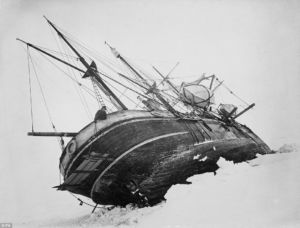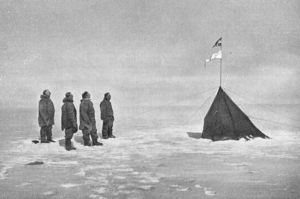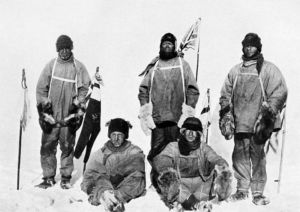Over 100 Years of Antarctic Exploration
 Exploration at the end of the world…
Exploration at the end of the world…
Now, more than 100 years after the first person reached the South Pole, modern day explorers continue to push the limits of human resilience and endurance with new Antarctic exploration challenges. Some expeditions are solo, some are on skis, some employ bicycles, but all require incredible physical and mental preparation and tenacity. We’ve listed some highlights of modern Antarctic adventures below but here’s a quick reminder on the history of Antarctic exploration:
Who is Shackleton?

Shackleton attempted to lead a team across the Antarctic continent in 1914. His famous ship, the Endurance, became trapped in early 1915 in the Antarctic ice pack. The ship was stuck in the Antarctic ice for 10 months, but Shackleton led a successful rescue expedition and everyone survived the journey.
Who is Amundsen?

A Norwegian explorer who led the first successful expedition to the South Pole in 1911.
Who is Scott?

A British explorer who was in a race with Amundsen to be the first to the South Pole. His team, eventually on foot after losing many of their supports along the way, reached the South Pole after Roald Amundsen’s Norwegian dogsled-powered team. His team perished on their return journey.
Modern Explorers
Henry Worsley
Nationality: UK
Goal: To complete the first solo, unsupported, unassisted crossing of the Antarctic land mass.
Inspiration: Worsley had a fascination with the Antarctic since childhood and was the first to have completed both of the classic routes to the South Pole following in the footsteps of Shackleton, Amundsen, and Scott. His final journey was a tribute to Shackleton and began 100 years after Shackleton’s 1915 attempt to cross the Antarctic continent. His trip, in addition to being a longtime goal and amazing endurance effort, was also a fundraiser for the The Endeavour Fund. The Endeavour Fund supports injured and wounded service personnel in their recovery efforts.
What happened? Henry Worsley set out on November 13, 2015. He made it 913 miles (30 miles short of his goal) before calling for help. During these 913 miles he pulled a sled that carried all of his food, a tent, and other equipment while skiing. He passed away in a Chilean hospital with bacterial peritonitis.
Felicity Aston
Nationality: UK
Feat: In January 2012, Felicity Aston became the first person to ski across Antarctica unassisted by kites or machines. She was the first woman to ski solo across the continent.
Inspiration: Aston initially went to Antarctica at age 23 to work as a research scientist. She subsequently completed numerous expeditions and adventures including the crossing of Greenland, a race to the North Pole, and she lead an expedition of international women to the South Pole. Aston stated that she undertook this mission to test her personal limits.
What happened? Her journey was 1,084 miles long and lasted 59 days. She pulled two sleds with 85kg of supplies and had 2 resupplies along the way.
Daniel Burton
Nationality: USA
Goal: To be the first person to bike to the South Pole.
Inspiration: Burton wanted to do something that has never been done before, bus was also motivated by an effort to highlight the obesity crisis in the US. Burton experienced a personal health crisis and also suffered the loss of his mother partially due to high cholesterol. He hoped to promote a culture of activity with his journey.
What happened? Burton spent 51 days biking 750 miles to the South Pole from the coast of Antarctica. He pulled two sleds behind him and had several resupplies along the way.
Ben Saunders
Nationality: UK
Goal: To be the first (along with his teammate Tarka L’Herpiniere) to complete the ill-fated Scott Terra Expedition of 1910: a 1795 mile journey on foot from the edge of Antarctica to the South Pole and back.
Inspiration: The British Antarctic exploration (1911-1912) led by Robert Falcon Scott.
What happened? Ben Saunders’ goal was to complete the 1800 mile journey from the coast of Antarctica to the South Pole and back. In the process, they reached the South Pole after 61 days. Their trip lasted 105 days and was the equivalent of completing 69 back-to-back marathons. He wanted to do the journey completely unsupported, but en route they had to call for one resupply plane which Saunders describes as one of the most difficult decisions of his life. Food was essential as they were consuming more than 6000 calories per day. This journey also set the record for the longest human-powered polar journey in history.
SOURCES:
http://www.spri.cam.ac.uk/picturelibrary/catalogue/bae1910-13/
http://scottexpedition.com/about
http://www.bbc.com/news/uk-35398552
http://www.felicityaston.co.uk/
http://www.theguardian.com/world/2012/jan/23/felicity-aston-ski-solo-antarctica
http://archive.sltrib.com/story.php?ref=/sltrib/news/57389591-78/burton-pole-wrote-expedition.html.csp



Leave a Reply